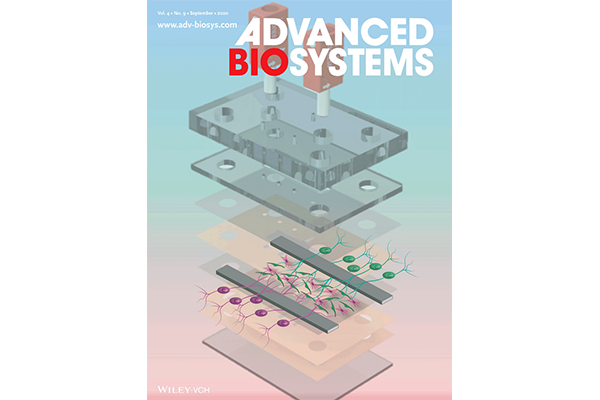Abigail and Ryan Koppes Featured on Inside Front Cover of Advanced Biosystems

ChE Assistant Professors Abigail Koppes and Ryan Koppes’ research on “Reconfigurable Microphysiological Systems for Modeling Innervation and Multitissue Interactions” was published in the September issue of Advanced Biosystems. To overcome the limitations of traditional organ chips, Ryan A. Koppes and co‐workers have implemented a “cut and assemble” manufacturing technique to exploit the meniscus pinning effect, via GelPins, to constrain 3D biomaterials. These GelPins enable the formation of discrete, yet contiguous hydrogel structures in both x‐y and z planes within custom microfluidic devices, facilitating future investigation of innervation and heterogenous tissue interactions.
Abstract:
Tissue‐engineered models continue to experience challenges in delivering structural specificity, nutrient delivery, and heterogenous cellular components, especially for organ‐systems that require functional inputs/outputs and have high metabolic requirements, such as the heart. While soft lithography has provided a means to recapitulate complex architectures in the dish, it is plagued with a number of prohibitive shortcomings. Here, concepts from microfluidics, tissue engineering, and layer‐by‐layer fabrication are applied to develop reconfigurable, inexpensive microphysiological systems that facilitate discrete, 3D cell compartmentalization, and improved nutrient transport. This fabrication technique includes the use of the meniscus pinning effect, photocrosslinkable hydrogels, and a commercially available laser engraver to cut flow paths. The approach is low cost and robust in capabilities to design complex, multilayered systems with the inclusion of instrumentation for real‐time manipulation or measures of cell function. In a demonstration of the technology, the hierarchal 3D microenvironment of the cardiac sympathetic nervous system is replicated. Beat rate and neurite ingrowth are assessed on‐chip and quantification demonstrates that sympathetic‐cardiac coculture increases spontaneous beat rate, while drug‐induced increases in beating lead to greater sympathetic innervation. Importantly, these methods may be applied to other organ‐systems and have promise for future applications in drug screening, discovery, and personal medicine.